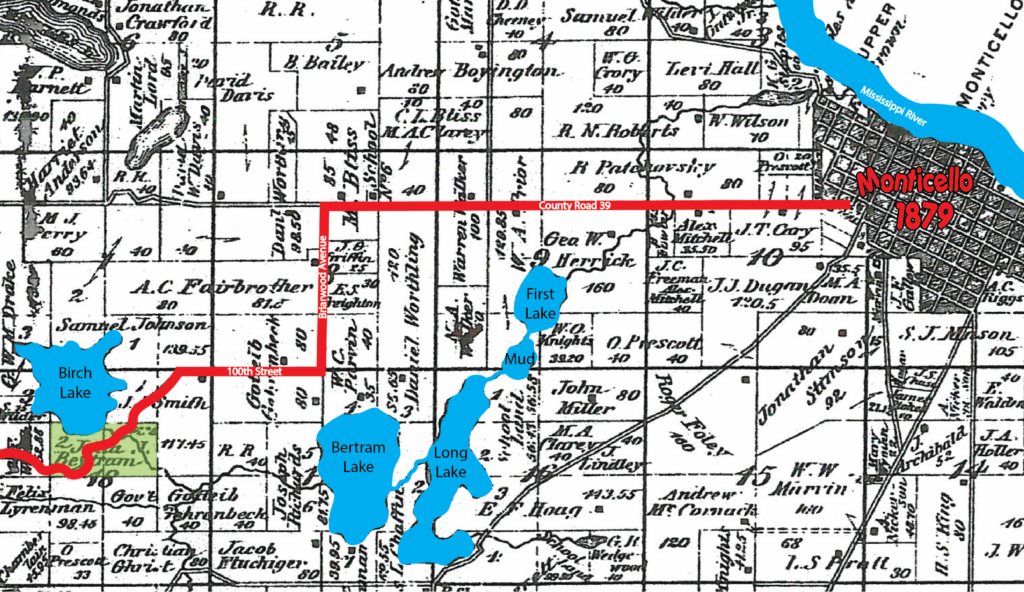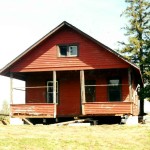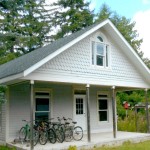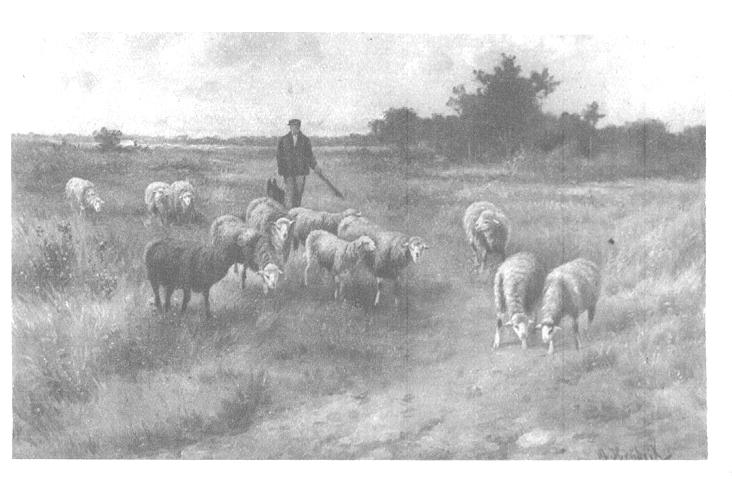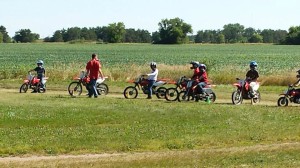Briarwood Avenue
Briarwood Avenue is the main road along the western edge of the new Bertram Chain of Lakes Regional Park. It will eventually be the major access to the Park, as well as the Athletic Complex. But, Briarwood Avenue did not always run along the edge of Bertram Lake. according to county plat maps, in 1879, the original road came south from County Road 39 but turned at 100th Street and continued west, over the hill and through the woods along the south side of Birch Lake.
Also, in earlier times (1850’s & 1860’s) at the corner of 100th and Briarwood, a wagon trail went south around the west side of Bertram Lake and behind the later built Keibel farm. It continued around the south sides of both Bertram and Long Lakes, and into Monticello. 90th Street would later be built over the Monticello part until it connected with Cahill Avenue. The part of Briarwood from 100th would later be connected around Bertram to 90th Street.
On a side note, when the road continued west along the south side of Birch Lake, it went through property owned by none other than Julia Bertram, George Bertram’s wife.
Bertram Lakes Cabins
 There have always been questions as to the existence of cabins on the property, especially near Bertram Lake.
There have always been questions as to the existence of cabins on the property, especially near Bertram Lake.
In 1901, a man named Daniel Worthling owned lot #4 of section 9 and lot #3 of section 17 in Monticello Township. These lots included the land from the Bertram Lake Beach north to County Road 39. By 1915, these same plots of land were owned by William Kiebel who built a farmstead just west of the new YMCA Camp.
Between the dates of 1901-1910, this postcard was sent to Newton, Iowa. It is dated September 1, 1906, and it is noted on the card, “This is where your SS (social studies) teacher is spending her vacation.” In the photograph, a girl is fishing with a cane pole sitting on what appears to be a slab of cement. In the background there are two women, a young child and a tent. The location is at Bertram Beach with the oak trees. In the upper right of the photo is the gap in the trees where the access road enters.
Camping, it appears, has at least been happening since the early 1900’s, and continued into the early 1990’s. As for cabins, very little is known and it has been speculated about over the years. Rumor has it that at least three cabins were located west of the beach alongside of the trail leading to the new chalet building. One site may have been located right under the current path from the parking lot.
Continued research is needed, but it is known that the area at and near the beach has been enjoyed by many generations of nature lovers!
The Oscar Kiebel Farm
In an earlier Tidbit, I mentioned there were nine farms located on the Bertram Lakes property that were acquired, over time, by the Y.M.C.A. One of the last that was purchased was located on the east side of Briarwood Avenue a quarter mile north of 90th Street, and was known as the Oscar Kiebel Farm.
The house itself has an interesting history because it was an early version of the “pre-fab” houses, although in today’s terms it really wasn’t.
80 to 90 years ago, Sears and other companies were creating what was referred to as “Railroad Houses”. There were several designs to choose from but the basic concept was the same. All of the pieces of the house were pre-cut and marked to indicate what it was and where it went. For example, boards were marked as joists, rafters, studs, etc., and were numbered to show their position. A master plan showed where each board went and the carpenters or home owner simply followed the diagram.
At the factory after each house was cut and marked, it was packaged and sent by the railroad to the town nearest the final location of the home. In this case, it was shipped to the Monticello Railroad Depot to be picked up by the owner.
This house, in particular, served as the primary residence for the Oscar Kiebel family. This house is currently located near 90th Street, approximately one mile west of its original location.
An Oak and its Acorn
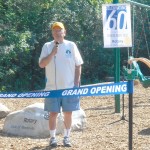 I have been asked to retell the story of the oak tree that I told at the opening ceremony of the Natural Theme Playground. I hope that it will be of interest to the readers.
I have been asked to retell the story of the oak tree that I told at the opening ceremony of the Natural Theme Playground. I hope that it will be of interest to the readers.
In June of 1985, I began working for the YMCA supervising summer youth employment students ages 14-17. One of the tasks was to make sure the beach area was clean and well organized. The “Y” Day Camp used the beach, as well as a few weekend campers.
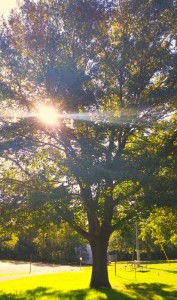
Next to the road that goes by the beach area was an old, hollowed out oak tree that was struggling to stay alive. As stated in an earlier tidbit, “Cecropia Moth”, many old oak tress rot from the inside out, with the cambium layer still alive. This old oak tree was definitely hollowed out with a couple of feet of sawdust chips in the center. Plus, there was one live branch growing out of the side that extended several feet into the air. This branch was still producing acorns and, in the past, one of them had fallen into the “sawdust” in the center of the tree. Miraculously, the acorn had taken root and was at least 7-8 feet tall!
Over the next two years, this old tree gave out and we had to cut down what was left of it. Without the old tree surrounding it, the new young oak grew stronger by itself and now, 40 years later, it is the magnificent tree that we can see and enjoy today (see picture at right)! But we must remember that nature renews itself in its own time and not in ours. Appreciate the tree for what it is, beauty, shade and renewal.
In the previous tidbit, Farms II, I mentioned that the farmers who owned and operated the Bertram Lakes land were stewards or “trustees” of the land. As we enter the final stages of the purchase of this land, we must remind ourselves of this stewardship. I recently came across a quote that is very fitting for us. It reads as follows:
As we enter our own stewardship, let us remind ourselves that we need to preserve, protect, and improve when we can so that future generations can enjoy the land also.
The Farms ~ Part II
The YMCA’s interest in the Bertram Chain of Lakes land first came from donations/purchases by the Lehigh Cement company which owned land on the east side of the lakes, including First Lake.
During the next 15 years (from 1952-1967) neighboring farms were bought up as they began to cease operations. Most of these farms were small one-family operations of dairy, small grain, sheep and cattle and provided a life for these families for almost 100+ years (from 1850-1950+).
These farms were purchased one at a time until the current land area of the Bertram Chain of Lakes was created. All together there are nine (9) farmsteads that can be located on the land, several of which have old foundations and other remains to show where they were.
In the future when all of the land has been purchased and the entire natural area of the park is open to the public, these farmsteads will be marked showing the last two farmers/owners of the land.
Several of these farms produced some specialty crops:
- The corner of Briarwood & 90th Street (horse pasture) was originally a field where sheep were raised for many years. They produced wool, mutton & chops.
- Inside the south entrance and just southeast of the parking lot was the site of a very specific crop; this was the site of a mink farm. The pelts of the mink were used for coats and stoles. Changing attitudes led to its demise.
- Rumor has it that there was a celery farm located near Long Lake but the specific location has not been found.
- Of course,m the YMCA used the land to farm Christmas trees for sale in the cities. Several of the areas are still in existence today but will be redone in the future.
We must be sure to remember and celebrate these early stewards of the land!
YMCA Detached Worker
 I first became aware of this phase in the mid 1970’s when a YMCA Detached Worker was assigned to the Monticello area through the Manitou Camp, located on the south end of Bertram Lake. A worker by the name of Mike M. came to the Monticello High School and introduced himself to be the YMCA person who would be coordinating programs in the schools in conjunction with Camp Manitou. The YMCA has always been instrumental in the social issues of children and created the Detached Worker Program to help struggling children with school, home and personal issues. I asked Mike where the “Detached Worker” part came in because I didn’t see him coming “apart” in any way! We laughed and he explained that he was a YMCA employee but that he had no office or specific role other than to help disadvantaged, neglected and/or forgotten children who needed help, guidance, structure, and a person to care about them. Since the detached worker was not restricted to hours, he or she could work with children of all ages and at all times ~ especially afternoons and evenings outside of regular school times.
I first became aware of this phase in the mid 1970’s when a YMCA Detached Worker was assigned to the Monticello area through the Manitou Camp, located on the south end of Bertram Lake. A worker by the name of Mike M. came to the Monticello High School and introduced himself to be the YMCA person who would be coordinating programs in the schools in conjunction with Camp Manitou. The YMCA has always been instrumental in the social issues of children and created the Detached Worker Program to help struggling children with school, home and personal issues. I asked Mike where the “Detached Worker” part came in because I didn’t see him coming “apart” in any way! We laughed and he explained that he was a YMCA employee but that he had no office or specific role other than to help disadvantaged, neglected and/or forgotten children who needed help, guidance, structure, and a person to care about them. Since the detached worker was not restricted to hours, he or she could work with children of all ages and at all times ~ especially afternoons and evenings outside of regular school times.
Some of the activities included camping trips, group work, volunteer activities, sports, games, and family referrals. One very popular program the Mini Bike Program. The YMCA had secured a partnership with Honda to provide some mini bikes to Camp Manitou. Each year students would learn about the bikes and how to handle and ride them safely. After the basic introduction, they would practice riding them in an oval to help them hone their skills. The final result was to go on a trail ride throughout the YMCA-Bertram property. In the end they would clean and maintain the bikes for the next trail ride; similar to the book, “Zen and Art of Motorcycle Maintenance”, except they were mini bikes. This program lasted over 25 years and educated hundreds of children in the Monticello area on mini bike safety.
Cecropia Moth
 When looking at and remembering history, we are too often forced to look at it in human terms but, plants, insects and animals have always had their own influences, in in some instances, very serious impact on human history. In this case, I had a very interesting and beautiful encounter with an insect in the Bertram Lakes area.
When looking at and remembering history, we are too often forced to look at it in human terms but, plants, insects and animals have always had their own influences, in in some instances, very serious impact on human history. In this case, I had a very interesting and beautiful encounter with an insect in the Bertram Lakes area.
It was the summer of 1990, while supervising some summer youth employment students. We were engaged in some cleanup near the beach area of Bertram Lake. A storm had come through and left some of the oak trees with broken branches and scattered leaves. One of the older trees ha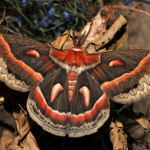 d received a lightning strike that left it in fairly bad shape. We had decided that it needed to come down and proceeded to trim all the branches away. As I began using the chainsaw on the upper trunk, I felt little resistance to the saw. It soon became apparent that the tree was hollow and in fact, very hollow. After cutting several feet off the upper trunk we could look inside and see that the entire bottom was covered, 3 feet deep, with course sawdust. In looking through the sawdust, I found several (6-10) very large larvae, all about the size of a finger. They were off-white with a faint green hue and about 3/4 of an inch thick. They could be nothing less than the larvae of the Cecropia Moth. The largest of the moth family in North America. Recognizing this, we stopped cutting, covered the top with branches and leaves and left it alone until the next year.
d received a lightning strike that left it in fairly bad shape. We had decided that it needed to come down and proceeded to trim all the branches away. As I began using the chainsaw on the upper trunk, I felt little resistance to the saw. It soon became apparent that the tree was hollow and in fact, very hollow. After cutting several feet off the upper trunk we could look inside and see that the entire bottom was covered, 3 feet deep, with course sawdust. In looking through the sawdust, I found several (6-10) very large larvae, all about the size of a finger. They were off-white with a faint green hue and about 3/4 of an inch thick. They could be nothing less than the larvae of the Cecropia Moth. The largest of the moth family in North America. Recognizing this, we stopped cutting, covered the top with branches and leaves and left it alone until the next year.
I can only hope that they all survived. I was very happy and awed to see how nature compliments itself by providing what is necessary for its components to survive. Beauty isn’t always in what we can see, but it’s hidden all around us!
